A Critical Analysis of a Cloud Computing Article: Research Report
VerifiedAdded on 2023/03/29
|7
|1906
|68
Report
AI Summary
This report presents a critical analysis of a research article on cloud computing, specifically examining its application in management education. The analysis evaluates the article's introduction, problem statement, literature review, methodology, and conclusions. The report critiques the clarity of the title, the problem addressed, and the literature review's organization. The methodology, which employed qualitative analysis, is reviewed for its clarity and completeness. The conclusion of the original study, which highlighted the potential of cloud computing in education, is summarized. Overall, the analysis provides insights into the strengths and weaknesses of the original research, emphasizing the importance of clear problem statements, well-structured literature reviews, and comprehensive methodologies in academic research within the field of cloud computing.
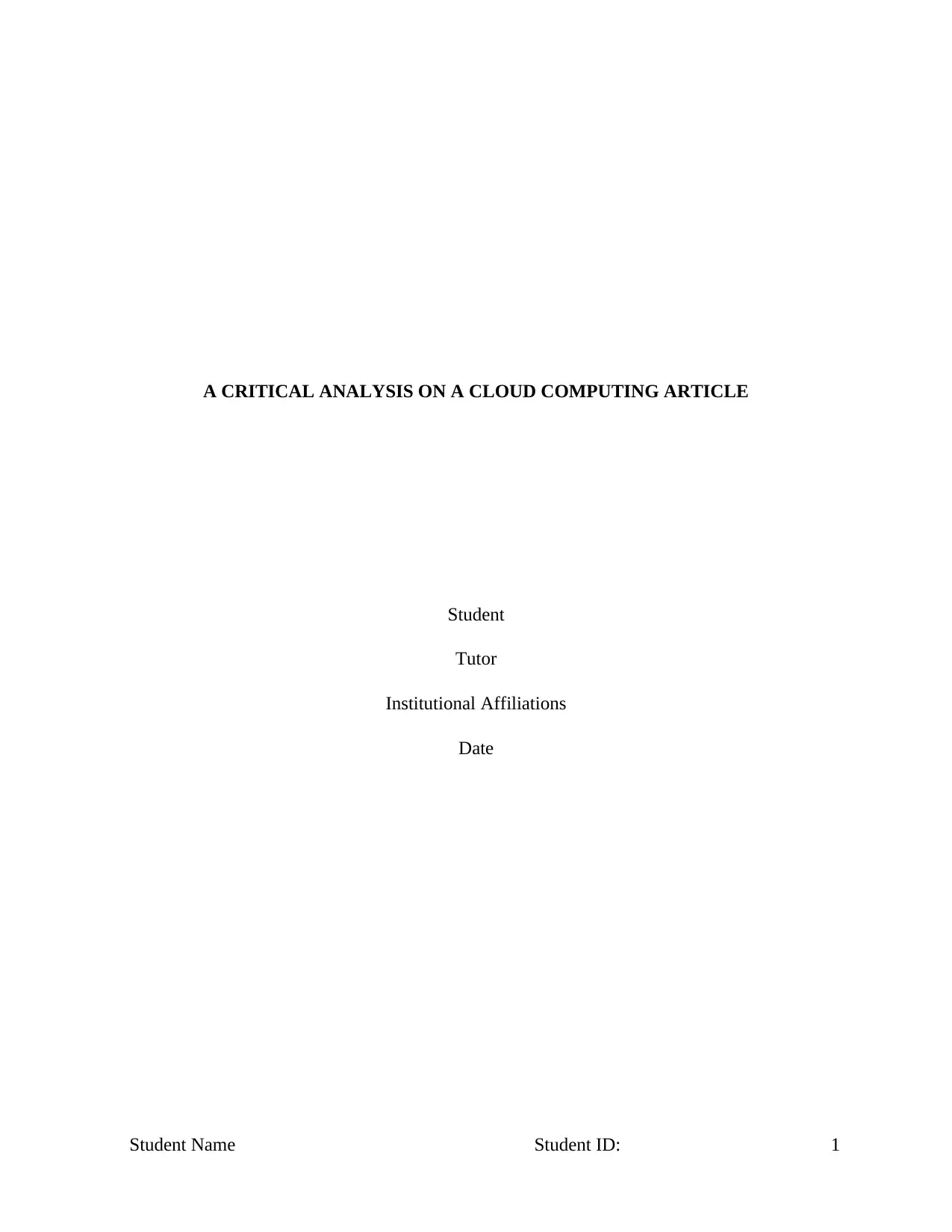
A CRITICAL ANALYSIS ON A CLOUD COMPUTING ARTICLE
Student
Tutor
Institutional Affiliations
Date
Student Name Student ID: 1
Student
Tutor
Institutional Affiliations
Date
Student Name Student ID: 1
Paraphrase This Document
Need a fresh take? Get an instant paraphrase of this document with our AI Paraphraser
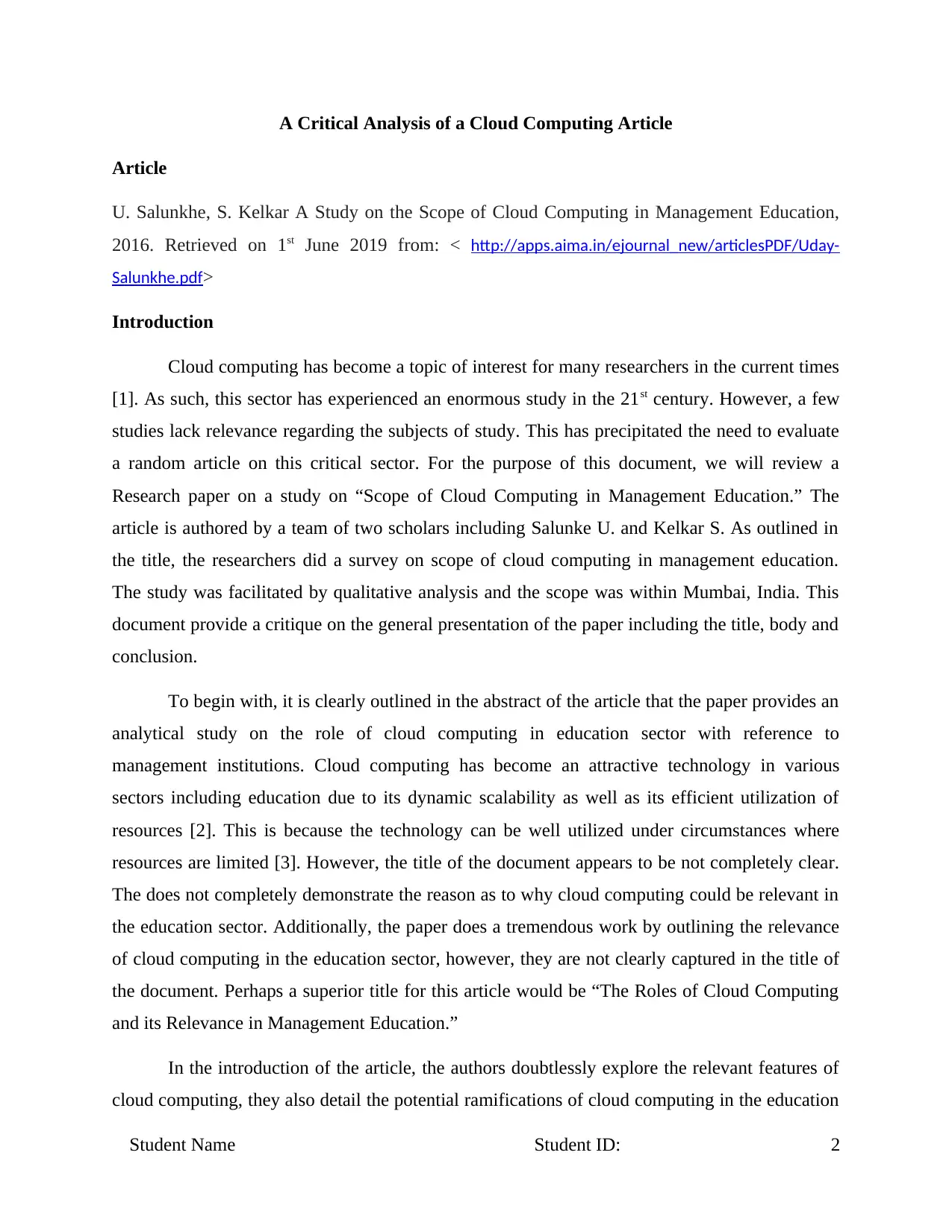
A Critical Analysis of a Cloud Computing Article
Article
U. Salunkhe, S. Kelkar A Study on the Scope of Cloud Computing in Management Education,
2016. Retrieved on 1st June 2019 from: < http://apps.aima.in/ejournal_new/articlesPDF/Uday-
Salunkhe.pdf>
Introduction
Cloud computing has become a topic of interest for many researchers in the current times
[1]. As such, this sector has experienced an enormous study in the 21st century. However, a few
studies lack relevance regarding the subjects of study. This has precipitated the need to evaluate
a random article on this critical sector. For the purpose of this document, we will review a
Research paper on a study on “Scope of Cloud Computing in Management Education.” The
article is authored by a team of two scholars including Salunke U. and Kelkar S. As outlined in
the title, the researchers did a survey on scope of cloud computing in management education.
The study was facilitated by qualitative analysis and the scope was within Mumbai, India. This
document provide a critique on the general presentation of the paper including the title, body and
conclusion.
To begin with, it is clearly outlined in the abstract of the article that the paper provides an
analytical study on the role of cloud computing in education sector with reference to
management institutions. Cloud computing has become an attractive technology in various
sectors including education due to its dynamic scalability as well as its efficient utilization of
resources [2]. This is because the technology can be well utilized under circumstances where
resources are limited [3]. However, the title of the document appears to be not completely clear.
The does not completely demonstrate the reason as to why cloud computing could be relevant in
the education sector. Additionally, the paper does a tremendous work by outlining the relevance
of cloud computing in the education sector, however, they are not clearly captured in the title of
the document. Perhaps a superior title for this article would be “The Roles of Cloud Computing
and its Relevance in Management Education.”
In the introduction of the article, the authors doubtlessly explore the relevant features of
cloud computing, they also detail the potential ramifications of cloud computing in the education
Student Name Student ID: 2
Article
U. Salunkhe, S. Kelkar A Study on the Scope of Cloud Computing in Management Education,
2016. Retrieved on 1st June 2019 from: < http://apps.aima.in/ejournal_new/articlesPDF/Uday-
Salunkhe.pdf>
Introduction
Cloud computing has become a topic of interest for many researchers in the current times
[1]. As such, this sector has experienced an enormous study in the 21st century. However, a few
studies lack relevance regarding the subjects of study. This has precipitated the need to evaluate
a random article on this critical sector. For the purpose of this document, we will review a
Research paper on a study on “Scope of Cloud Computing in Management Education.” The
article is authored by a team of two scholars including Salunke U. and Kelkar S. As outlined in
the title, the researchers did a survey on scope of cloud computing in management education.
The study was facilitated by qualitative analysis and the scope was within Mumbai, India. This
document provide a critique on the general presentation of the paper including the title, body and
conclusion.
To begin with, it is clearly outlined in the abstract of the article that the paper provides an
analytical study on the role of cloud computing in education sector with reference to
management institutions. Cloud computing has become an attractive technology in various
sectors including education due to its dynamic scalability as well as its efficient utilization of
resources [2]. This is because the technology can be well utilized under circumstances where
resources are limited [3]. However, the title of the document appears to be not completely clear.
The does not completely demonstrate the reason as to why cloud computing could be relevant in
the education sector. Additionally, the paper does a tremendous work by outlining the relevance
of cloud computing in the education sector, however, they are not clearly captured in the title of
the document. Perhaps a superior title for this article would be “The Roles of Cloud Computing
and its Relevance in Management Education.”
In the introduction of the article, the authors doubtlessly explore the relevant features of
cloud computing, they also detail the potential ramifications of cloud computing in the education
Student Name Student ID: 2
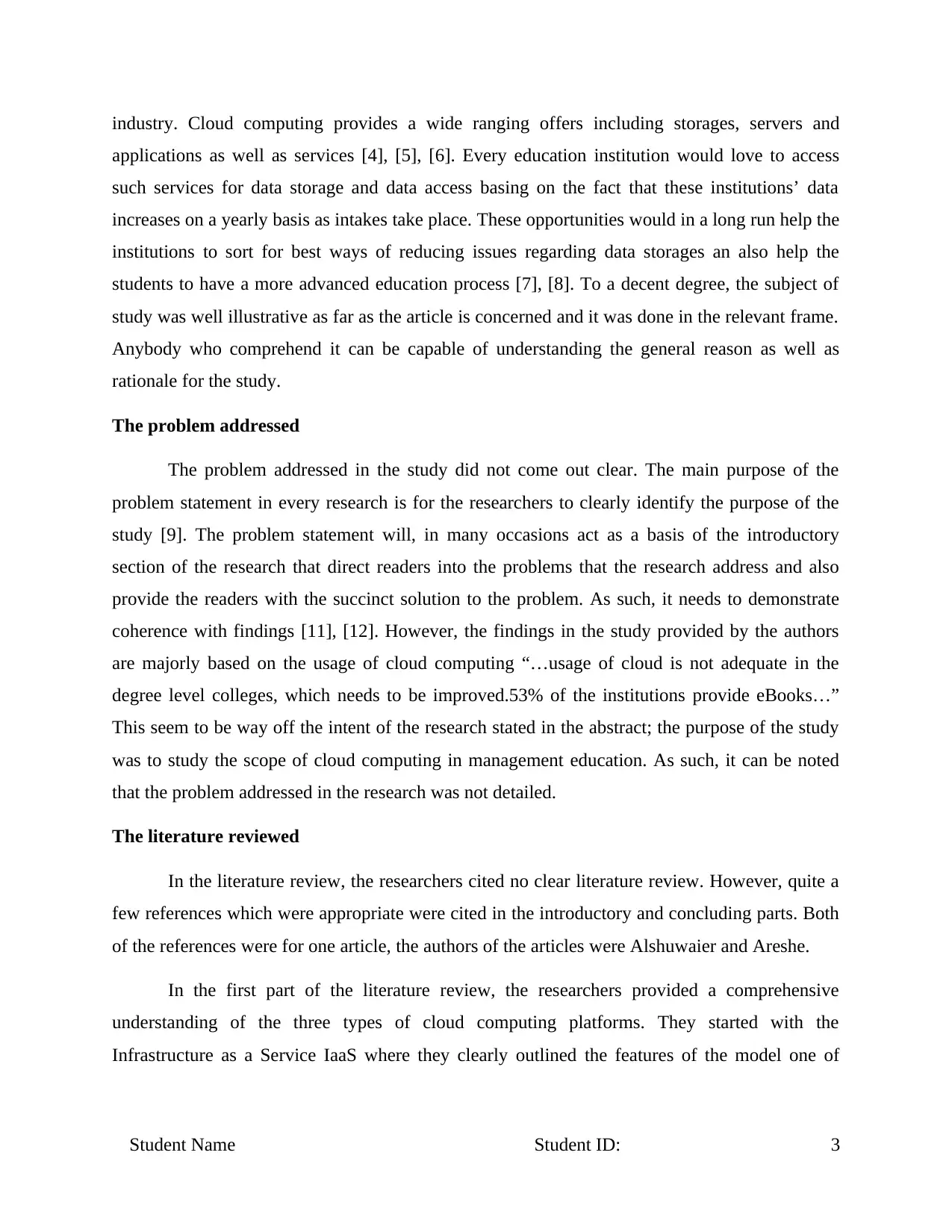
industry. Cloud computing provides a wide ranging offers including storages, servers and
applications as well as services [4], [5], [6]. Every education institution would love to access
such services for data storage and data access basing on the fact that these institutions’ data
increases on a yearly basis as intakes take place. These opportunities would in a long run help the
institutions to sort for best ways of reducing issues regarding data storages an also help the
students to have a more advanced education process [7], [8]. To a decent degree, the subject of
study was well illustrative as far as the article is concerned and it was done in the relevant frame.
Anybody who comprehend it can be capable of understanding the general reason as well as
rationale for the study.
The problem addressed
The problem addressed in the study did not come out clear. The main purpose of the
problem statement in every research is for the researchers to clearly identify the purpose of the
study [9]. The problem statement will, in many occasions act as a basis of the introductory
section of the research that direct readers into the problems that the research address and also
provide the readers with the succinct solution to the problem. As such, it needs to demonstrate
coherence with findings [11], [12]. However, the findings in the study provided by the authors
are majorly based on the usage of cloud computing “…usage of cloud is not adequate in the
degree level colleges, which needs to be improved.53% of the institutions provide eBooks…”
This seem to be way off the intent of the research stated in the abstract; the purpose of the study
was to study the scope of cloud computing in management education. As such, it can be noted
that the problem addressed in the research was not detailed.
The literature reviewed
In the literature review, the researchers cited no clear literature review. However, quite a
few references which were appropriate were cited in the introductory and concluding parts. Both
of the references were for one article, the authors of the articles were Alshuwaier and Areshe.
In the first part of the literature review, the researchers provided a comprehensive
understanding of the three types of cloud computing platforms. They started with the
Infrastructure as a Service IaaS where they clearly outlined the features of the model one of
Student Name Student ID: 3
applications as well as services [4], [5], [6]. Every education institution would love to access
such services for data storage and data access basing on the fact that these institutions’ data
increases on a yearly basis as intakes take place. These opportunities would in a long run help the
institutions to sort for best ways of reducing issues regarding data storages an also help the
students to have a more advanced education process [7], [8]. To a decent degree, the subject of
study was well illustrative as far as the article is concerned and it was done in the relevant frame.
Anybody who comprehend it can be capable of understanding the general reason as well as
rationale for the study.
The problem addressed
The problem addressed in the study did not come out clear. The main purpose of the
problem statement in every research is for the researchers to clearly identify the purpose of the
study [9]. The problem statement will, in many occasions act as a basis of the introductory
section of the research that direct readers into the problems that the research address and also
provide the readers with the succinct solution to the problem. As such, it needs to demonstrate
coherence with findings [11], [12]. However, the findings in the study provided by the authors
are majorly based on the usage of cloud computing “…usage of cloud is not adequate in the
degree level colleges, which needs to be improved.53% of the institutions provide eBooks…”
This seem to be way off the intent of the research stated in the abstract; the purpose of the study
was to study the scope of cloud computing in management education. As such, it can be noted
that the problem addressed in the research was not detailed.
The literature reviewed
In the literature review, the researchers cited no clear literature review. However, quite a
few references which were appropriate were cited in the introductory and concluding parts. Both
of the references were for one article, the authors of the articles were Alshuwaier and Areshe.
In the first part of the literature review, the researchers provided a comprehensive
understanding of the three types of cloud computing platforms. They started with the
Infrastructure as a Service IaaS where they clearly outlined the features of the model one of
Student Name Student ID: 3
⊘ This is a preview!⊘
Do you want full access?
Subscribe today to unlock all pages.

Trusted by 1+ million students worldwide
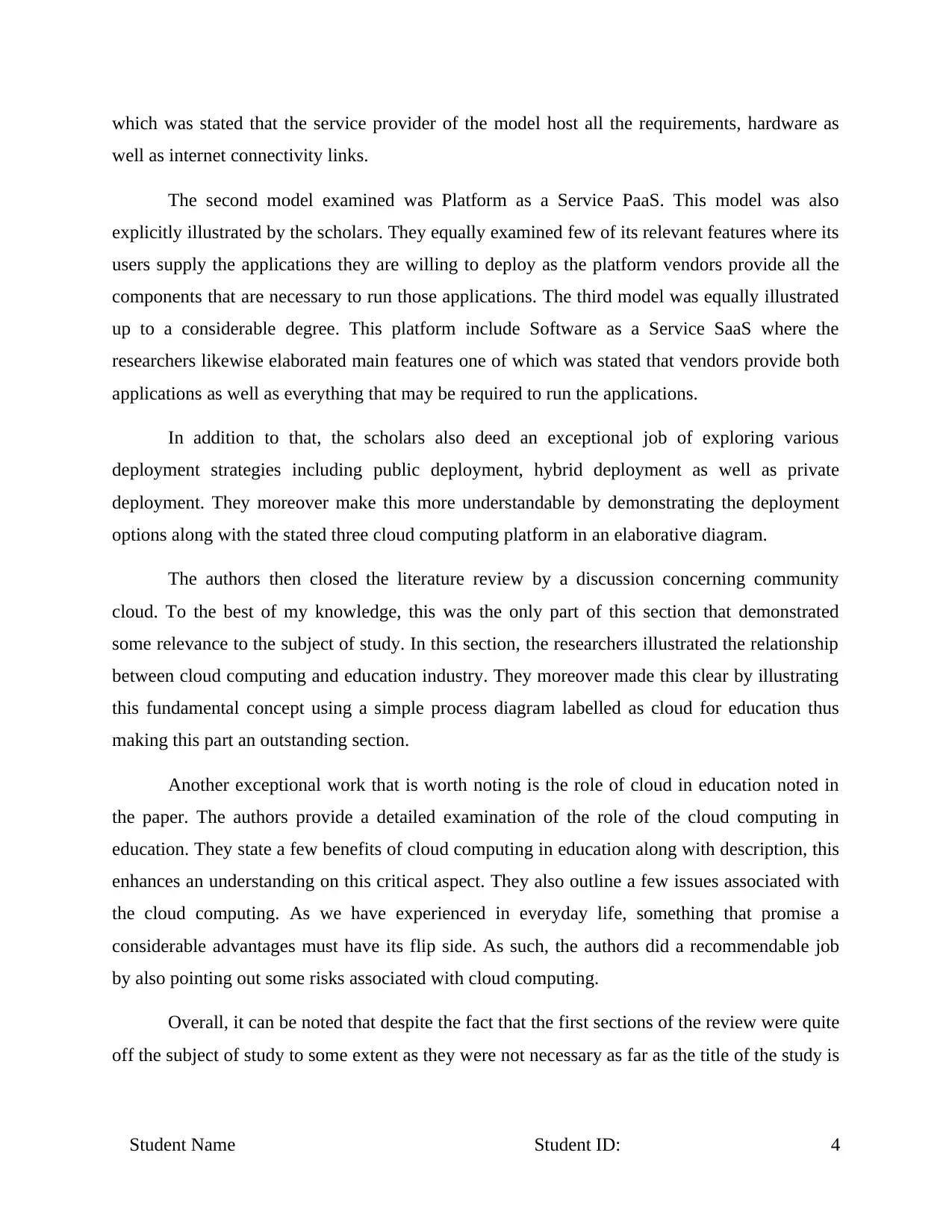
which was stated that the service provider of the model host all the requirements, hardware as
well as internet connectivity links.
The second model examined was Platform as a Service PaaS. This model was also
explicitly illustrated by the scholars. They equally examined few of its relevant features where its
users supply the applications they are willing to deploy as the platform vendors provide all the
components that are necessary to run those applications. The third model was equally illustrated
up to a considerable degree. This platform include Software as a Service SaaS where the
researchers likewise elaborated main features one of which was stated that vendors provide both
applications as well as everything that may be required to run the applications.
In addition to that, the scholars also deed an exceptional job of exploring various
deployment strategies including public deployment, hybrid deployment as well as private
deployment. They moreover make this more understandable by demonstrating the deployment
options along with the stated three cloud computing platform in an elaborative diagram.
The authors then closed the literature review by a discussion concerning community
cloud. To the best of my knowledge, this was the only part of this section that demonstrated
some relevance to the subject of study. In this section, the researchers illustrated the relationship
between cloud computing and education industry. They moreover made this clear by illustrating
this fundamental concept using a simple process diagram labelled as cloud for education thus
making this part an outstanding section.
Another exceptional work that is worth noting is the role of cloud in education noted in
the paper. The authors provide a detailed examination of the role of the cloud computing in
education. They state a few benefits of cloud computing in education along with description, this
enhances an understanding on this critical aspect. They also outline a few issues associated with
the cloud computing. As we have experienced in everyday life, something that promise a
considerable advantages must have its flip side. As such, the authors did a recommendable job
by also pointing out some risks associated with cloud computing.
Overall, it can be noted that despite the fact that the first sections of the review were quite
off the subject of study to some extent as they were not necessary as far as the title of the study is
Student Name Student ID: 4
well as internet connectivity links.
The second model examined was Platform as a Service PaaS. This model was also
explicitly illustrated by the scholars. They equally examined few of its relevant features where its
users supply the applications they are willing to deploy as the platform vendors provide all the
components that are necessary to run those applications. The third model was equally illustrated
up to a considerable degree. This platform include Software as a Service SaaS where the
researchers likewise elaborated main features one of which was stated that vendors provide both
applications as well as everything that may be required to run the applications.
In addition to that, the scholars also deed an exceptional job of exploring various
deployment strategies including public deployment, hybrid deployment as well as private
deployment. They moreover make this more understandable by demonstrating the deployment
options along with the stated three cloud computing platform in an elaborative diagram.
The authors then closed the literature review by a discussion concerning community
cloud. To the best of my knowledge, this was the only part of this section that demonstrated
some relevance to the subject of study. In this section, the researchers illustrated the relationship
between cloud computing and education industry. They moreover made this clear by illustrating
this fundamental concept using a simple process diagram labelled as cloud for education thus
making this part an outstanding section.
Another exceptional work that is worth noting is the role of cloud in education noted in
the paper. The authors provide a detailed examination of the role of the cloud computing in
education. They state a few benefits of cloud computing in education along with description, this
enhances an understanding on this critical aspect. They also outline a few issues associated with
the cloud computing. As we have experienced in everyday life, something that promise a
considerable advantages must have its flip side. As such, the authors did a recommendable job
by also pointing out some risks associated with cloud computing.
Overall, it can be noted that despite the fact that the first sections of the review were quite
off the subject of study to some extent as they were not necessary as far as the title of the study is
Student Name Student ID: 4
Paraphrase This Document
Need a fresh take? Get an instant paraphrase of this document with our AI Paraphraser
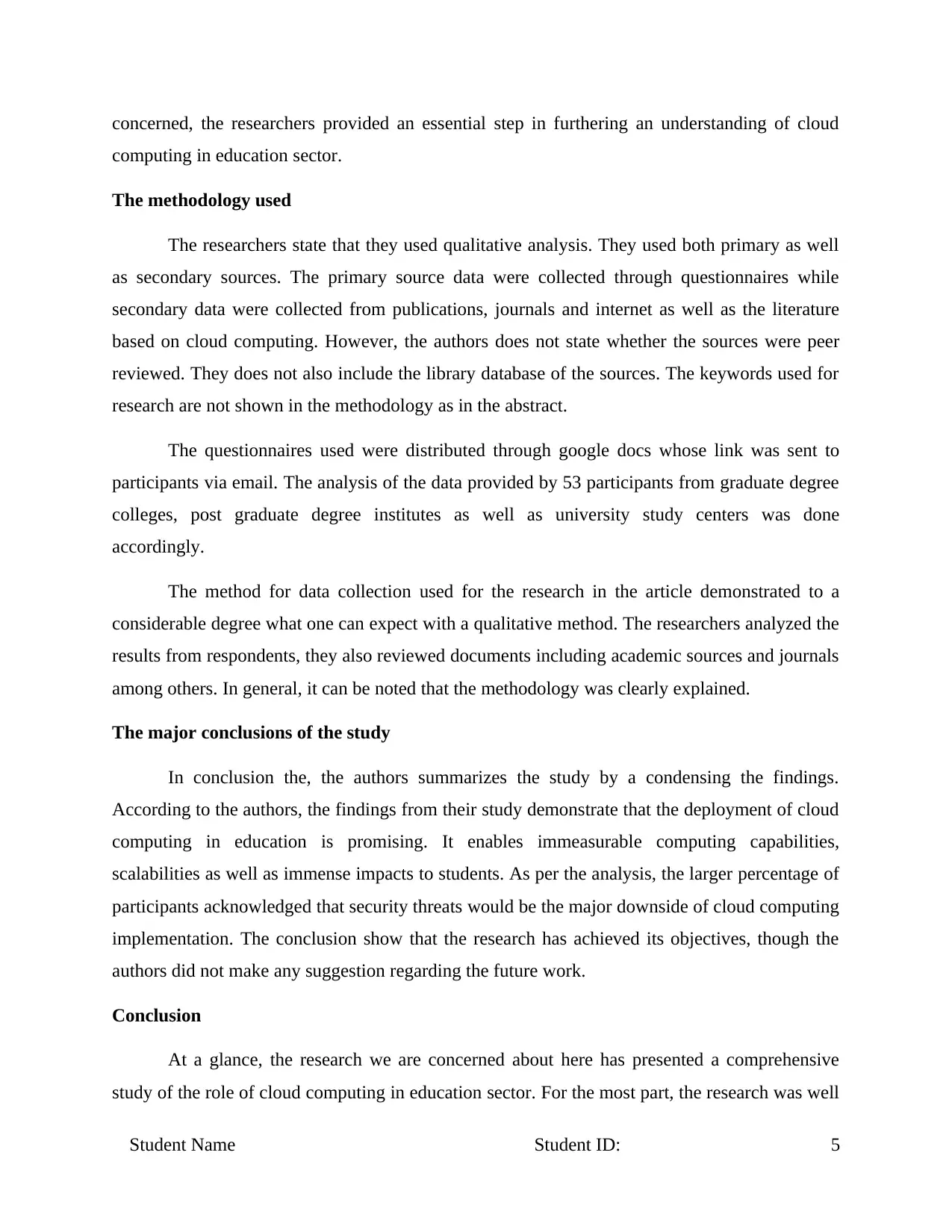
concerned, the researchers provided an essential step in furthering an understanding of cloud
computing in education sector.
The methodology used
The researchers state that they used qualitative analysis. They used both primary as well
as secondary sources. The primary source data were collected through questionnaires while
secondary data were collected from publications, journals and internet as well as the literature
based on cloud computing. However, the authors does not state whether the sources were peer
reviewed. They does not also include the library database of the sources. The keywords used for
research are not shown in the methodology as in the abstract.
The questionnaires used were distributed through google docs whose link was sent to
participants via email. The analysis of the data provided by 53 participants from graduate degree
colleges, post graduate degree institutes as well as university study centers was done
accordingly.
The method for data collection used for the research in the article demonstrated to a
considerable degree what one can expect with a qualitative method. The researchers analyzed the
results from respondents, they also reviewed documents including academic sources and journals
among others. In general, it can be noted that the methodology was clearly explained.
The major conclusions of the study
In conclusion the, the authors summarizes the study by a condensing the findings.
According to the authors, the findings from their study demonstrate that the deployment of cloud
computing in education is promising. It enables immeasurable computing capabilities,
scalabilities as well as immense impacts to students. As per the analysis, the larger percentage of
participants acknowledged that security threats would be the major downside of cloud computing
implementation. The conclusion show that the research has achieved its objectives, though the
authors did not make any suggestion regarding the future work.
Conclusion
At a glance, the research we are concerned about here has presented a comprehensive
study of the role of cloud computing in education sector. For the most part, the research was well
Student Name Student ID: 5
computing in education sector.
The methodology used
The researchers state that they used qualitative analysis. They used both primary as well
as secondary sources. The primary source data were collected through questionnaires while
secondary data were collected from publications, journals and internet as well as the literature
based on cloud computing. However, the authors does not state whether the sources were peer
reviewed. They does not also include the library database of the sources. The keywords used for
research are not shown in the methodology as in the abstract.
The questionnaires used were distributed through google docs whose link was sent to
participants via email. The analysis of the data provided by 53 participants from graduate degree
colleges, post graduate degree institutes as well as university study centers was done
accordingly.
The method for data collection used for the research in the article demonstrated to a
considerable degree what one can expect with a qualitative method. The researchers analyzed the
results from respondents, they also reviewed documents including academic sources and journals
among others. In general, it can be noted that the methodology was clearly explained.
The major conclusions of the study
In conclusion the, the authors summarizes the study by a condensing the findings.
According to the authors, the findings from their study demonstrate that the deployment of cloud
computing in education is promising. It enables immeasurable computing capabilities,
scalabilities as well as immense impacts to students. As per the analysis, the larger percentage of
participants acknowledged that security threats would be the major downside of cloud computing
implementation. The conclusion show that the research has achieved its objectives, though the
authors did not make any suggestion regarding the future work.
Conclusion
At a glance, the research we are concerned about here has presented a comprehensive
study of the role of cloud computing in education sector. For the most part, the research was well
Student Name Student ID: 5
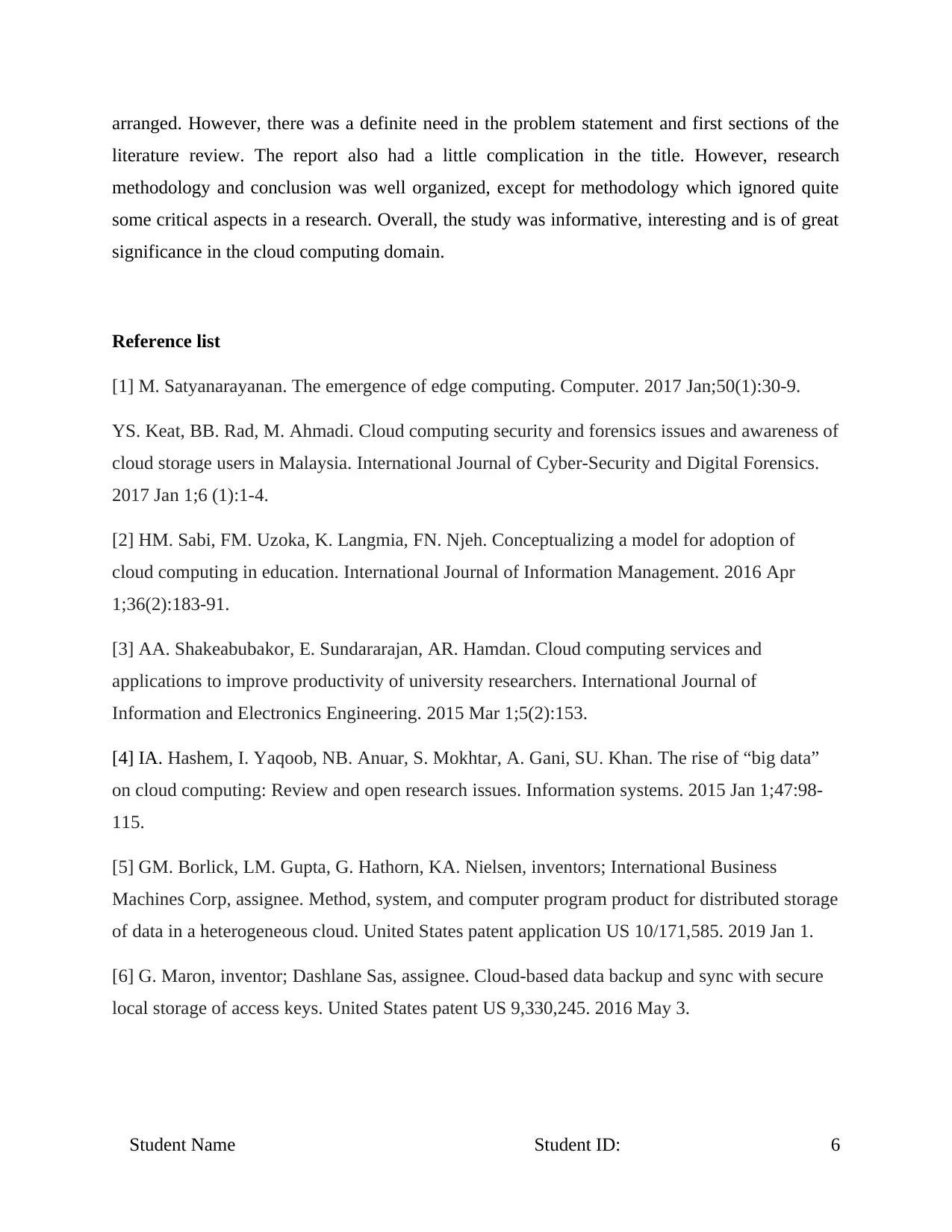
arranged. However, there was a definite need in the problem statement and first sections of the
literature review. The report also had a little complication in the title. However, research
methodology and conclusion was well organized, except for methodology which ignored quite
some critical aspects in a research. Overall, the study was informative, interesting and is of great
significance in the cloud computing domain.
Reference list
[1] M. Satyanarayanan. The emergence of edge computing. Computer. 2017 Jan;50(1):30-9.
YS. Keat, BB. Rad, M. Ahmadi. Cloud computing security and forensics issues and awareness of
cloud storage users in Malaysia. International Journal of Cyber-Security and Digital Forensics.
2017 Jan 1;6 (1):1-4.
[2] HM. Sabi, FM. Uzoka, K. Langmia, FN. Njeh. Conceptualizing a model for adoption of
cloud computing in education. International Journal of Information Management. 2016 Apr
1;36(2):183-91.
[3] AA. Shakeabubakor, E. Sundararajan, AR. Hamdan. Cloud computing services and
applications to improve productivity of university researchers. International Journal of
Information and Electronics Engineering. 2015 Mar 1;5(2):153.
[4] IA. Hashem, I. Yaqoob, NB. Anuar, S. Mokhtar, A. Gani, SU. Khan. The rise of “big data”
on cloud computing: Review and open research issues. Information systems. 2015 Jan 1;47:98-
115.
[5] GM. Borlick, LM. Gupta, G. Hathorn, KA. Nielsen, inventors; International Business
Machines Corp, assignee. Method, system, and computer program product for distributed storage
of data in a heterogeneous cloud. United States patent application US 10/171,585. 2019 Jan 1.
[6] G. Maron, inventor; Dashlane Sas, assignee. Cloud-based data backup and sync with secure
local storage of access keys. United States patent US 9,330,245. 2016 May 3.
Student Name Student ID: 6
literature review. The report also had a little complication in the title. However, research
methodology and conclusion was well organized, except for methodology which ignored quite
some critical aspects in a research. Overall, the study was informative, interesting and is of great
significance in the cloud computing domain.
Reference list
[1] M. Satyanarayanan. The emergence of edge computing. Computer. 2017 Jan;50(1):30-9.
YS. Keat, BB. Rad, M. Ahmadi. Cloud computing security and forensics issues and awareness of
cloud storage users in Malaysia. International Journal of Cyber-Security and Digital Forensics.
2017 Jan 1;6 (1):1-4.
[2] HM. Sabi, FM. Uzoka, K. Langmia, FN. Njeh. Conceptualizing a model for adoption of
cloud computing in education. International Journal of Information Management. 2016 Apr
1;36(2):183-91.
[3] AA. Shakeabubakor, E. Sundararajan, AR. Hamdan. Cloud computing services and
applications to improve productivity of university researchers. International Journal of
Information and Electronics Engineering. 2015 Mar 1;5(2):153.
[4] IA. Hashem, I. Yaqoob, NB. Anuar, S. Mokhtar, A. Gani, SU. Khan. The rise of “big data”
on cloud computing: Review and open research issues. Information systems. 2015 Jan 1;47:98-
115.
[5] GM. Borlick, LM. Gupta, G. Hathorn, KA. Nielsen, inventors; International Business
Machines Corp, assignee. Method, system, and computer program product for distributed storage
of data in a heterogeneous cloud. United States patent application US 10/171,585. 2019 Jan 1.
[6] G. Maron, inventor; Dashlane Sas, assignee. Cloud-based data backup and sync with secure
local storage of access keys. United States patent US 9,330,245. 2016 May 3.
Student Name Student ID: 6
⊘ This is a preview!⊘
Do you want full access?
Subscribe today to unlock all pages.

Trusted by 1+ million students worldwide
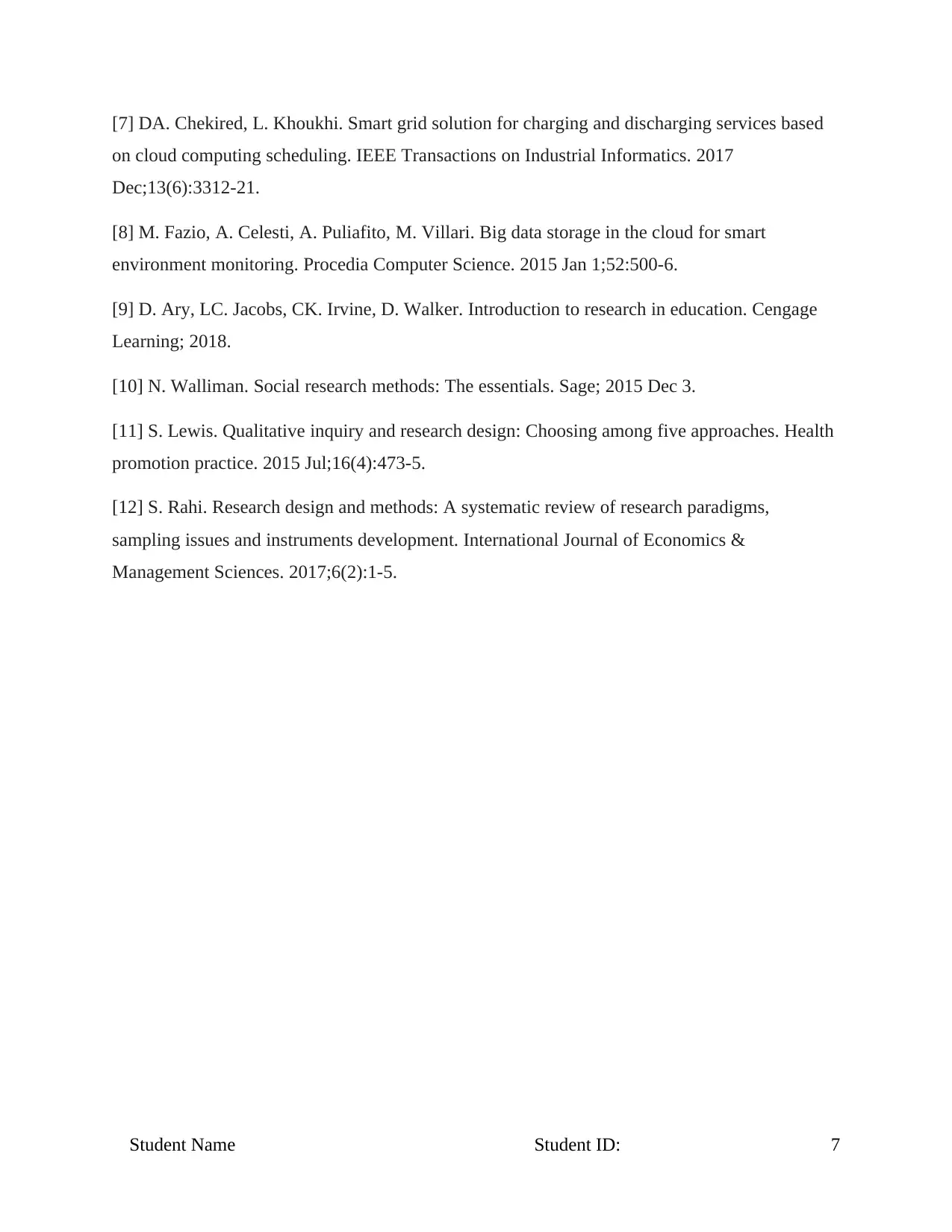
[7] DA. Chekired, L. Khoukhi. Smart grid solution for charging and discharging services based
on cloud computing scheduling. IEEE Transactions on Industrial Informatics. 2017
Dec;13(6):3312-21.
[8] M. Fazio, A. Celesti, A. Puliafito, M. Villari. Big data storage in the cloud for smart
environment monitoring. Procedia Computer Science. 2015 Jan 1;52:500-6.
[9] D. Ary, LC. Jacobs, CK. Irvine, D. Walker. Introduction to research in education. Cengage
Learning; 2018.
[10] N. Walliman. Social research methods: The essentials. Sage; 2015 Dec 3.
[11] S. Lewis. Qualitative inquiry and research design: Choosing among five approaches. Health
promotion practice. 2015 Jul;16(4):473-5.
[12] S. Rahi. Research design and methods: A systematic review of research paradigms,
sampling issues and instruments development. International Journal of Economics &
Management Sciences. 2017;6(2):1-5.
Student Name Student ID: 7
on cloud computing scheduling. IEEE Transactions on Industrial Informatics. 2017
Dec;13(6):3312-21.
[8] M. Fazio, A. Celesti, A. Puliafito, M. Villari. Big data storage in the cloud for smart
environment monitoring. Procedia Computer Science. 2015 Jan 1;52:500-6.
[9] D. Ary, LC. Jacobs, CK. Irvine, D. Walker. Introduction to research in education. Cengage
Learning; 2018.
[10] N. Walliman. Social research methods: The essentials. Sage; 2015 Dec 3.
[11] S. Lewis. Qualitative inquiry and research design: Choosing among five approaches. Health
promotion practice. 2015 Jul;16(4):473-5.
[12] S. Rahi. Research design and methods: A systematic review of research paradigms,
sampling issues and instruments development. International Journal of Economics &
Management Sciences. 2017;6(2):1-5.
Student Name Student ID: 7
1 out of 7
Related Documents
Your All-in-One AI-Powered Toolkit for Academic Success.
+13062052269
info@desklib.com
Available 24*7 on WhatsApp / Email
![[object Object]](/_next/static/media/star-bottom.7253800d.svg)
Unlock your academic potential
Copyright © 2020–2025 A2Z Services. All Rights Reserved. Developed and managed by ZUCOL.





